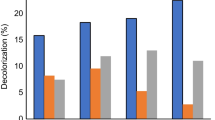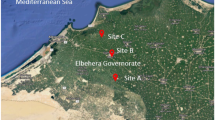Abstract
Supplementation of consortium comprising of aboriginal bacterial species with high degradation capacity can significantly enhance the biodegradation process of the domestic wastewater. The present study examined the bioremediation of domestic wastewater using a novel bacterial consortium comprising of five autochthonous bacterial strains with high potential for reduction in BOD, COD and protein content to 89%, 55% and 86%, respectively after 24 h of incubation. HPLC and GC–MS analyses revealed that the chosen consortium had successfully degraded wide-ranging complex organic compounds, which is crucial in the decontamination of wastewater. Phytotoxicity assay of the effluent exhibited that the seeds of Vigna radiata showed better growth and germination when subjected to wastewater treated by novel bacterial consortium as compared to the seeds exposed to untreated wastewater. Further, raw and treated wastewater were assessed for their genotoxicity with comet assay which displayed the intensity of DNA damage in the Allium cepa root tip cells before and after exposure to treated effluent. It is evident from the demonstrated results that the formulated bacterial consortium can be used successfully in a small-scale wastewater treatment plant.
Graphical abstract





Similar content being viewed by others
References
Ahmed SA, Flórez MG, Karanis P (2018) The impact of water crises and climate changes on the transmission of protozoan parasites in Africa. Pathog Glob Health 112(6):281–293
Alobaidy AHMJ, Al-Sameraiy MA, Kadhem AJ, Majeed AA (2010) Evaluation of treated municipal wastewater quality for irrigation. J Environ Prot 1(03):216–225
Aneja KR (2004) Experiments in microbiology, plant pathology and biotechnology. New Age International (P) Limited, New Delhi
APHA (2005) Standard methods for the examination of water and waste water, 21st edn. American Public Health Association, Washington, USA
Azaizeh H, Kurzbaum E, Said O, Jaradat H, Menashe O (2015) The potential of autochthonous microbial culture encapsulation in a confined environment for phenol biodegradation. Environ Sci Pollut R 22:15179–15187
Balabanič D, Filipič M, Klemenčič AK, Žegura B (2017) Raw and biologically treated paper mill wastewater effluents and the recipient surface waters: cytotoxic and genotoxic activity and the presence of endocrine disrupting compounds. Sci Total Environ 574:78–89
Chakraborty R, Mukherjee AK, Mukherjee A (2009) Evaluation of genotoxicity of coal fly ash in Allium cepa root cells by combining comet assay with the Allium test. Environ Monit Assess 153(1–4):351–357
Chen Q, Ni J, Ma T, Liu T, Zheng M (2015) Bioaugmentation treatment of municipal wastewater with heterotrophic-aerobic nitrogen removal bacteria in a pilot-scale SBR. Bioresour Technol 183:25–32
CPCB (2007) Evaluation of operation and maintenance of sewage treatment plants in India 2007, control of urban pollution series: CUPS/68/2007. Central Pollution Control Board, India
Dahiya S, Venkata Mohan S (2016) Strategic design of synthetic consortium with embedded wastewater treatment potential: deciphering the competence of isolates from diverse microbiome. Front Environ Sci 4:30
Das MT, Budhraja V, Mishra M, Thakur IS (2012) Toxicological evaluation of paper mill sewage sediment treated by indigenous dibenzofuran-degrading Pseudomonas sp. Bioresour Technol 110:71–78
El Bestawy E, Ahmed AH, Amer R, Kashmeri RA (2014) Decontamination of domestic wastewater using suspended individual and mixed bacteria in batch system. J Bioremed Biodeg 5(5):231
Escarpa A, González MC (2000) Identification and quantitation of phenolics from green beans by high-performance liquid chromatography. Chromatographia 52(1–2):33–38
Gaikwad GL, Wate SR, Ramteke DS, Roychoudhury K (2014) Development of microbial consortia for the effective treatment of complex wastewater. J Bioremed Biodegred 5(4):1. https://doi.org/10.4172/2155-6199.1000227
Garcha S, Verma N, Brar SK (2016) Isolation, characterization and identification of microorganisms from unorganized dairy sector wastewater and sludge samples and evaluation of their biodegradability. Water Res Ind 16:19–28
Hesnawi R, Dahmani K, Al-Swayah A, Mohamed S, Mohammed SA (2014) Biodegradation of municipal wastewater with local and commercial bacteria. Procedia Eng 70:810–814
Holt JG, Krieg NR, Sneath PH, Staley JT, Williams ST (1994) Bergey’s manual of determinative bacteriology. William & Wilkins, Baltimore, pp 786–788
Jadhav JP, Kalyani DC, Telke AA, Phugare SS, Govindwar SP (2010) Evaluation of the efficacy of a bacterial consortium for the removal of color, reduction of heavy metals, and toxicity from textile dye effluent. Bioresour Technol 101:165–173
Junnarkar N, Murty DS, Bhatt NS, Madamwar D (2006) Decolorization of diazo dye Direct Red 81 by a novel bacterial consortium. World J Microbiol Biotechnol 22(2):163–168
Kumar S, Stecher G, Tamura K (2016) MEGA7: molecular evolutionary genetics analysis version 7.0 for bigger datasets. Mol Biol Evol 33:1870–1874
Lowry OH, Rosebrough NJ, Farr AL, Randall RJV (1951) Protein measurement with the Folin phenol reagent. J Biol Chem 193(1):265–275
Lynd LR, Weimer PJ, Van Zyl WH, Pretorius IS (2002) Microbial cellulose utilization: fundamentals and biotechnology. Microbiol Mol Biol Rev 66(3):506–577
Mazumdar H, Ahmed GU (2011) Synthesis of silver nanoparticles and its adverse effect on seed germinations in Oryza sativa, Vigna radiata and Brassica campestris. Int J Adv Biotechnol Res 2(4):404–413
Mehrotra T, Srivastava A, Rao RP, Singh R (2019) A novel immobilized bacterial consortium bioaugmented in a bioreactor for sustainable wastewater treatment. J Pure Appl Microbiol 13(1):371–383
Mohan SV, Falkentoft C, Nancharaiah YV, Sturm BS, Wattiau P, Wilderer PA, Wuertz S, Hausner M (2009) Bioaugmentation of microbial communities in laboratory and pilot scale sequencing batch biofilm reactors using the TOL plasmid. Bioresour Technol 100(5):1746–1753
Phugare SS, Kalyani DC, Surwase SN, Jadhav JP (2011) Ecofriendly degradation, decolorization and detoxification of textile effluent by a developed bacterial consortium. Ecotoxicol Environ Saf 74(5):1288–1296
Porwal HJ, Mane AV, Velhal SG (2015) Biodegradation of dairy effluent by using microbial isolates obtained from activated sludge. Water Res Ind 9:1–15
Rais A, Afandhi A, Prasetya B (2019) Analysis of water pollution in tertiary ditch using macroinvertebrate in Songka village of palopo City. Indones J Environ Sustain Dev. https://doi.org/10.21776/ub.jpal.2019.010.01.02
Rajkumar N, Subramani T, Elango L (2010) Ground water contamination Dueto municipal solid waste disposal—a GIS based study in Erode City. Int J Environ Sci 1(1):39–55
Ramakrishnan B (2012) Microbial community tracking in bioremediation. J Bioremed Biodeg 3:e123. https://doi.org/10.4172/2155-6199.1000e123
Saitou N, Nei M (1987) The neighbor-joining method: a new method for reconstructing phylogenetic trees. Mol Biol Evol 4:406–425
Shankar S, Kansrajh C, Dinesh MG, Satyan RS, Kiruthika S, Tharanipriya A (2014) Application of indigenous microbial consortia in bioremediation of oil-contaminated soils. Int J Environ Sci Technol 11(2):367–376
Sonune N, Garode A (2018) Isolation, characterization and identification of extracellular enzyme producer Bacillus licheniformis from municipal wastewater and evaluation of their biodegradability. Biotechnol Res Innov 2(1):37–44. https://doi.org/10.1016/j.biori.2018.03.001
Srivastava AK, Rana SV, Mehrotra T, Singh R (2016) Characterization and immobilization of bacterial consortium for its application in degradation of dairy effluent. J Pure Appl Microbiol 10(3):2199–2209
Tamura K, Nei M, Kumar S (2004) Prospects for inferring very large phylogenies by using the neighbor-joining method. Proc Natl Acad Sci (USA) 101:11030–11035
Wang M, Yang G, Min H, Lv Z, Jia X (2009) Bioaugmentation with the nicotine degrading bacterium Pseudomonas sp. HF-1 in a sequencing batch reactor treating tobacco wastewater: degradation study and analysis of its mechanisms. Water Res 43:4187–4196
Yadav S, Chandra R (2012) Biodegradation of organic compounds of molasses melanoidin (MM) from biomethanated distillery spent wash (BMDS) during the decolourisation by a potential bacterial consortium. Biodegradation 23(4):609–620
Acknowledgements
The authors are grateful to Amity Institute of Biotechnology, Amity University Uttar Pradesh, for providing the laboratory facilities and funds to carry out the work smoothly. The authors are thankful to Mr. Surya Pratap Singh Shakya, Amity Institute of Pharmacy, Amity University Uttar Pradesh for doing HPLC analysis, Mr. Ajay Kumar, AIRF, JNU, New Delhi for doing GC–MS analysis and Dr. Saras Jyoti, Research Associate, Amity Institute of Molecular Medicine and Stem Cell Research, Amity University Uttar Pradesh for doing the confocal fluorescence microscopy. The authors are also grateful to the reviewers for their suggestions that helped immensely in giving the manuscript its present form.
Author information
Authors and Affiliations
Corresponding author
Ethics declarations
Conflict of interest
All authors declare that they have no conflict of interest.
Ethical approval
This article does not contain any studies with human participants or animals performed by any of the authors.
Informed consent
Informed consent was obtained from all individual participants included in the study.
Additional information
Publisher's Note
Springer Nature remains neutral with regard to jurisdictional claims in published maps and institutional affiliations.
Electronic supplementary material
Below is the link to the electronic supplementary material.
Rights and permissions
About this article
Cite this article
Mehrotra, T., Shukla, A. & Singh, R. In vitro toxicological evaluation of domestic effluent treated by formulated synthetic autochthonous bacterial consortium. World J Microbiol Biotechnol 35, 184 (2019). https://doi.org/10.1007/s11274-019-2756-0
Received:
Accepted:
Published:
DOI: https://doi.org/10.1007/s11274-019-2756-0




